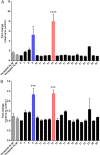Ecdysteroid Derivatives that Reverse P-Glycoprotein-Mediated Drug Resistance
- PMID: 32790992
- PMCID: PMC8009596
- DOI: 10.1021/acs.jnatprod.0c00334
Ecdysteroid Derivatives that Reverse P-Glycoprotein-Mediated Drug Resistance
Abstract
The expression of multidrug resistance P-glycoprotein (P-gp) by cancer cells represents one of the major drawbacks to successful cancer therapy. Accordingly, the development of drugs that inhibit the activity of this transporter remains a major challenge in cancer drug discovery. In this context, several new ecdysteroid derivatives have been synthesized and evaluated as P-gp inhibitors. Two of them (compounds 9 and 14) were able to resensitize CEMVbl100 and LoVoDoxo resistant cell lines to vinblastine and doxorubicin, respectively. Indeed, both compounds 9 and 14 increased the cellular accumulation of rhodamine 123 in cells expressing P-gp and stimulated basal P-glycoprotein-ATPase activity at a 1 μM concentration, demonstrating their interference with the transport of other substrates in a competitive mode. Moreover, in a medulloblastoma cell line (DAOY), compounds 9 and 14 reduced the side population representing cancer stem cells, which are characterized by a high expression of ABC drug transporters. Further, in DAOY cells, the same two compounds synergized with cisplatin and vincristine, two drugs used commonly in the therapy of medulloblastoma. Molecular docking studies on the homology-modeled structure of the human P-glycoprotein provided a rationale for the biological results, validating the binding mode within the receptor site, in accordance with lipophilicity data and observed structure-activity relationship information. Altogether, the present results endorse these derivatives as promising P-gp inhibitors, and they may serve as candidates to reverse drug resistance in cancer cells.
Conflict of interest statement
The authors declare no competing financial interest.
Figures










References
MeSH terms
Substances
LinkOut - more resources
Full Text Sources
Miscellaneous

